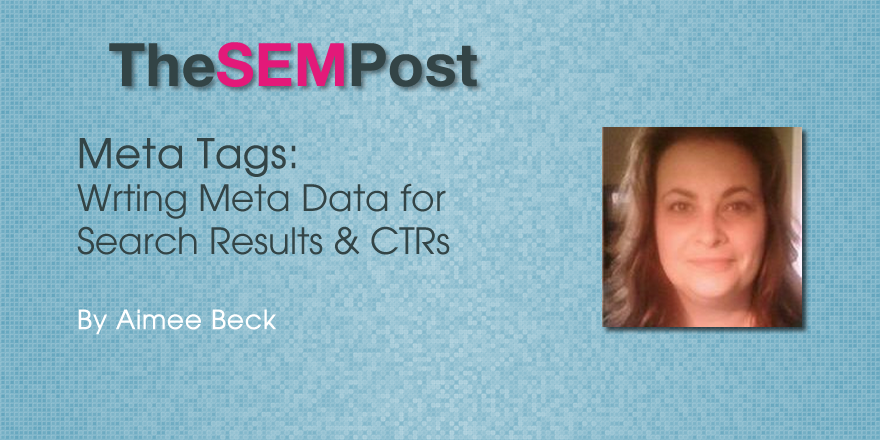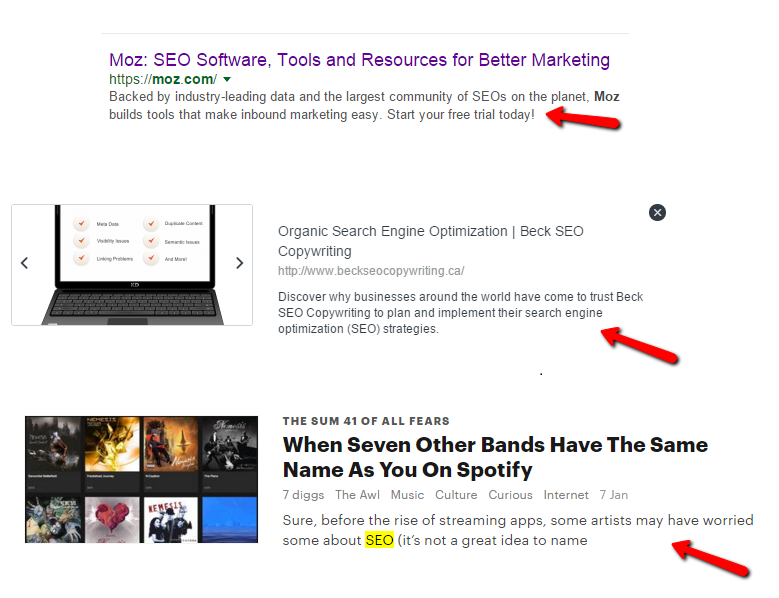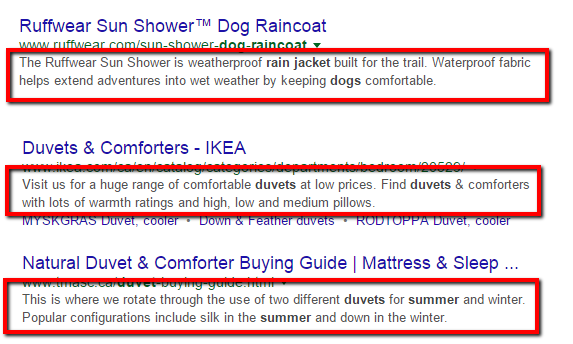

In a recent Content Marketing Institute post, Moz founder Rand Fishkin discusses the inevitable search engine ranking factor changes on the horizon, one of which is relevant click-through rate (CTR). In the not-so-distant future, search engines will be able to determine if your page is getting more clicks than the ones above it in the SERP (search engines results pages). If that’s the case, your page may be rewarded with a ranking boost.
The next logical question would be, “How do I improve my search engine CTRs?” The short answer is: meta data. But not just any old meta data — more specifically, Titles & Descriptions.
What is Meta Data?
Search engines use meta data to determine what a page is all about, and to determine if the page’s content is relevant to the searched query. Search engines display the title and meta description in the results pages. When written properly, these two elements can help entice the searcher to click on your listing vs. that of your competitors.
Titles are a big part of Google, Bing and Yahoo’s search ranking algorithms. The title tag automatically creates the clickable hyperlink in SERPs, the title when bookmarking a page, and in the tab on your browser.
The meta description has never been a Google ranking factor, but it has always been used by smart marketers to improve CTRs. The meta description is (almost always) used as the text beneath the title in the results pages, in social media posts when OGP tags aren’t utilized, and social bookmarking networks use the description tag to auto-populate their results.
Both tags live within the <head> section of the HTML code, like this:
This code creates what the user sees when he performs a search query, like this:

I’ve said (countless times) that these two SEO elements can make or break the visibility of your web pages. That’s because the search engine results pages are your first opportunity for conversion – to get the click. And now, as the search landscape changes yet again, getting that click not only means getting traffic to your site, it also means a ranking boost … which means even more traffic to your site.
The second reason properly written meta data is so important is because a bounce rate can negatively impact your site’s rankings. When users search Google, click a link in the results page, then quickly bounce back to the results page, it indicates to Google that users aren’t finding what they need on your pages.
This begs the question, why aren’t users getting what they thought they’d get when clicking those links to your pages. It could be that your title and description tags aren’t telling the whole story, or maybe they’re telling the wrong story all together.
How to Improve Your SERP CTR
Write compelling, informative titles & meta descriptions. Sounds simple enough, right? Wrong. Typically, web developers end up writing meta data. But they’re not writers, and they’re not SEOs — and those are the only people who should actually be writing your tags.
Think about it — just like the title of a fiction novel, the SEO Title is the very first thing a person reads. In a split second, the reader decides whether or not to continue reading or move on to the next title.
With that in mind, would you task your on-demand printing guys to come up with the title of your book? Then don’t let developers come up with the titles for your web pages. (No offense, devs, your talents are invaluable!)
Show Me Your Sizzlin’ Hot SEO Titles
The recipe for writing the perfect SEO title isn’t all that difficult once you have all the ingredients. Titles should:
- be unique on every page
- contain a keyword phrase relevant to the topic of the page
- clearly describe the contents of the page
- compel the reader to click through
Here’s how write strong SEO titles:
- Be sure to describe the page — don’t get so caught up in the sizzle that you forget about the steak
- You only have about 55 characters, including spaces, to work with in the title — so keep it short and punchy. No fluff.
- Keywords still matter. It’s how search engines determine if a page is relevant to the search query, so try to use your priority keyword phrase up front.
- If you can use secondary keywords, go for it! But don’t cram them in there just for the sake of it. Quality of writing always comes first.
- For quite some time, it’s been a best practice to include a pipe ( | ) then branding at the end of titles, but it’s not a rule. Personally, I feel it’s more important to craft a well-written title that entices the user to click than to ensure a company name gets tacked on to the end. There’s no rule that says you have to do it one way or the other. If branding is super important to your business, then by all means use it in the title.
- Use attention-grabbing words to evoke emotion. Try adjectives like secret, hidden, exciting, and verbs like discover, reveal and expose.
Here are some great examples of titles I’ve recently seen:
And some not-so-great titles:
Writing Meta Descriptions that Inform and Compel
If, after reading the title, the searcher hasn’t yet clicked through to your page, they’ll quickly glance at the description — that little blurb of text beneath the clickable hyperlink. This is your second (and final) opportunity to get the click.
Here are some tips on writing descriptions to further entice the user to click your SERP listing:
- Write one or two brief sentences that clearly explain what the reader can expect to find on the page after they click through.
- Google displays approximately 155 characters (including spaces) in its descriptions before chopping them off like this…
- Include relevant keywords if it makes sense to do so — keywords that match the user’s query will appear b0ld in the SERPs.
- Include benefit statements and/or calls to action. Tell the reader what you want them to do next — click through to learn more, read more, sign up, contact, download, join the conversation, etc.
- Tell readers what’s in it for them by giving them a reason to click through. Using benefit statements works well to entice the click.
Some great examples of descriptions I’ve recently seen:
When a user types a keyword phrase into a search engine, their intent is clear — they have a need. They may have a burning question, or they might want to do some shopping. They could be doing research for a college paper or perhaps they’re in search of home remedies.
Whatever the case may be, they’re searching for something. When you’re writing meta data, keep the user in mind. What problem is this web page solving? What answer is it giving? What product is it selling? This valuable piece of SERP real estate is your chance to convince the user that your page has what they need.
The immediate future of SEO reinforces the importance of writing for real live human beings, not search engines. When you write on-page copy, titles and descriptions with the reader in mind, you’re sure to improve your click-through rates, which will soon improve your rankings, too.
Aimee Beck
Latest posts by Aimee Beck (see all)
- 3 DIY SEO Action Items for a $0 Budget - April 22, 2016
- Meta Tags: Writing Meta Data for Search Results & CTRs - March 29, 2016
- 4 Ways to Breathe New Life Into Old, Tired Content - January 25, 2016
- Quick ‘n Dirty Content Marketing Strategy Checklist - October 8, 2015
- Evergreen Content – Sow the Seeds & Reap the Benefits - June 11, 2015








Edmund Pegen says
Hi Aimee, great post. Bookmarked and shared with my friends.
I’ve always called page titles and meta descriptions the gift that keeps on giving.. Get em right and you reap the benefits for ever.
Cheers
Ed
Edmund Pelgen says
You think I could spell my own surname. That’s Pelgen 🙂
Aimee Beck says
You’re bang on, Edmund! Thanks for sharing 🙂
Pat Mingarelli says
The article says, “Search engines use meta data to determine what a page is all about, and to determine if the page’s content is relevant to the searched query.”
And
“The meta description has never been a Google ranking factor, but it has always been used by smart marketers to improve CTRs”
How does Meta data differ from the meta description?
Thank you!
Aimee Beck says
Hi Pat! Meta descriptions are a type of meta data. Meta data is simply data that describes / provides information about other data. Here’s some more info that may help: https://en.wikipedia.org/wiki/Metadata